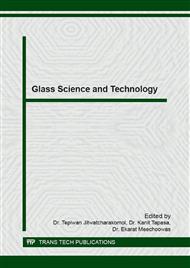[1]
L. L. Hench, R. J. Splinter, W. C. Allen, T. K. Greenlee, Bonding mechanisms at the interface of ceramic prosthetic materials. J. Biomed. Mater. Res. 5 (1971), p.117–141.
DOI: 10.1002/jbm.820050611
Google Scholar
[2]
L. L. Hench, H. A. Paschall, Direct chemical bond of bioactive glass-ceramic materials to bone and muscle. J. Biomed. Mater. Res. 7 (1973), p.25–42.
DOI: 10.1002/jbm.820070304
Google Scholar
[3]
J. Wilson, G. H. Pigott, F. J. Schoen, L. L. Hench, Toxicology and biocompatibility of bioglasses. J. Biomed. Mater. Res. 15 (1981), p.805– 817.
DOI: 10.1002/jbm.820150605
Google Scholar
[4]
Stefan Romeisa , Alexander Hoppeb , Rainer Detschb , Aldo R. Boccaccinib , Jochen Schmidta , and Wolfgang Peukerta. Top-down processing of submicron 45S5 Bioglass® for enhanced in vitro bioactivity and biocompatibility. Procedia Engineering 2015; 102: 534–541.
DOI: 10.1016/j.proeng.2015.01.116
Google Scholar
[5]
Hench LL. Bioceramics. J Am Ceram Soc 1998; 81: 1705–28.
Google Scholar
[6]
Ebaretonbofa E and Evans. J G J. Porous mater 2002; 257-9.
Google Scholar
[7]
Elliott JC, Mackie PE, Young RA. Monoclinic hydroxyapatite. Science 1973; 180: 1055–7.
Google Scholar
[8]
De Groot K, Klein CPAT, Wolke JGC, De Blieck-Hogervorst JMA. Chemistry of calcium phosphate bioceramics. In: Yamamuro T, Hench LL, Wilson J, editors. Handbook of bioactive ceramics, vol. II. Boca Raton, FL: CRC Press, 1990. p.3–16.
DOI: 10.1002/jbm.820250709
Google Scholar
[9]
Jarcho M. Calcium phosphate ceramics as hard tissue prosthetics. Clin Orthop Relat Res 1981; 157: 259–78.
Google Scholar
[10]
Hench LL, Wilson J. Surface-active biomaterials. Science 1984; 226: 630–6.
Google Scholar
[11]
Ruys AJ, Brandwood A, Milthorpe BK, Dickson MR, Zeigler KA, Sorrell CC. The effect of sintering atmosphere on the chemical compatibility of hydroxyapatite and particulate additives at 12001C. J Mater Sci: Mater Med 1995; 6: 297–301.
DOI: 10.1007/bf00120274
Google Scholar
[12]
F.J. Garcı´a-Sanz, M.B. Mayor, J.L. Arias, J. Pou, B. Leo´ n,M. Pe´rez-Amor, Hydroxyapatite coatings: a comparative study between plasma-spray and pulsed laser deposition techniques, Journal of Material Science: Materials in Medicine 1997; 8: 861–865.
DOI: 10.1023/a:1018549720873
Google Scholar
[13]
R. Halouani, D. Bernache-Asolant, E. Champion, A. Ababou, Microstructure and related mechanical properties of hot pressed hydroxyapatite ceramics, Journal of Material Science: Materials in Medicine 1994; 5: 563–568.
DOI: 10.1007/bf00124890
Google Scholar
[14]
Healy KE, Ducheyne P. The mechanisms of passive dissolution of titanium in a model physiological environment. J Biomed Mater Res 1992; 26: 319–38.
DOI: 10.1002/jbm.820260305
Google Scholar
[15]
Long M, Rack HJ. Titanium alloys in total joint replacementFa materials science perspective. Biomaterials 1998; 19: 1621–39.
DOI: 10.1016/s0142-9612(97)00146-4
Google Scholar
[16]
Nanci A, Wuest JD, Peru L, Brunet P, Sharma V, Zalzal S, McKee MD. Chemical modification of titanium surfaces for covalent attachment of biological molecules. J Biomed Mater Res 1998; 40: 324–35.
DOI: 10.1002/(sici)1097-4636(199805)40:2<324::aid-jbm18>3.0.co;2-l
Google Scholar
[17]
Albrektsson T, Hansson HA. An ultrastructural characterization of the interface between bone and sputtered titanium or stainless steel surfaces. Biomaterials 1986; 7: 201–5.
DOI: 10.1016/0142-9612(86)90103-1
Google Scholar
[18]
K P Santosh, Min-Cheol Chu, A Balakrishnan, T N Kim and Seong-Jai Cho. Preparation and characterization of nano-hydroxyapatite powder using sol-gel technique. Bull Mater. Sci. October2009; Vol. 32 No. 5: 465-470.
DOI: 10.1007/s12034-009-0069-x
Google Scholar
[19]
Kokubo T, Takadama H, Biomaterials 2006; 27: 2907–15.
Google Scholar
[20]
A.J. Salinas, A.I. Martin, M. Vallet-Regi, Bioactivity of three CaO–P2O5–SiO2 sol–gel glasses, J. Biomed. Mater. Res. 61 (2002) 524–532.
DOI: 10.1002/jbm.10229
Google Scholar
[21]
P.N. De Aza, J.M. Ferna´ndez-Pradas, P. Serra, In vitro bioactivity of laser ablation pseudowollastonite coating, Biomaterials 25 (2004) 1983–(1990).
DOI: 10.1016/j.biomaterials.2003.08.036
Google Scholar
[22]
C. Sarmento, Z.B. Luklinska, L. Brown, M. Anseau, P.N. De Aza, S. De Aza, F.J. Hughes I.J. McKay, In vitro behavior of osteoblastic cells cultured in the presence of pseudowollastonite ceramic, J. Biomed. Mater. Res. 69A (2004) 351–358.
DOI: 10.1002/jbm.a.30012
Google Scholar
[23]
P.N. De Aza, Z.B. Luklinska, Martinez, M.R. Anseau, F. Guitian, S. De Aza, Morphological and structural study of pseudowollastonite implants in bone, J. Microsc. 197 (2000) 60–67.
DOI: 10.1046/j.1365-2818.2000.00647.x
Google Scholar
[24]
P.N. De Aza, Z.B. Luklinska, M.R. Anseau, F. Guitian, S. De Aza, Bioactivity of pseudowollastonite in human saliva, J. Dent. 27 (1999) 107–113.
DOI: 10.1016/s0300-5712(98)00029-3
Google Scholar
[25]
M.A. Lopes, J.D. Santos, F.J. Monteiro, J.C. Knowles, Glass-reinforced hydroxyapatite: a comprehensive study of the effect of glass composition on the crystallography of the composite, J. Biomed. Mater. Res. 39 (1998) 244–251.
DOI: 10.1002/(sici)1097-4636(199802)39:2<244::aid-jbm11>3.0.co;2-d
Google Scholar
[26]
F. Moztarzadeh, Electrical conductivity of Y2O3 stabilized zirconia, Ceram. Int. 14 (1988) 27–30.
DOI: 10.1016/0272-8842(88)90014-4
Google Scholar
[27]
Marta Cerrutia, David Greenspanb, Kevin Powers, Biomaterials 26 (2005) 1665–1674.
Google Scholar
[28]
Delia S. Brauer, Natalia Karpukhina, Matthew D. O'Donnell, Robert V. Law, Robert G. Hill, Fluoride-containing bioactive glasses: Effect of glass design and structure on degradation, pH and apatite formation in simulated body fluid. Acta Biomaterialia 6 (2010).
DOI: 10.1016/j.actbio.2010.01.043
Google Scholar
[29]
V.R. Mastelaro, E.D. Zanotto N. Lequeux, RCortes, J. Non-Cryst. Solids 262 (2000) 191–199.
Google Scholar
[30]
P. Ducheyne, Q. Qiu, Biomaterials 20 (1999) 2287 – 2303.
Google Scholar


